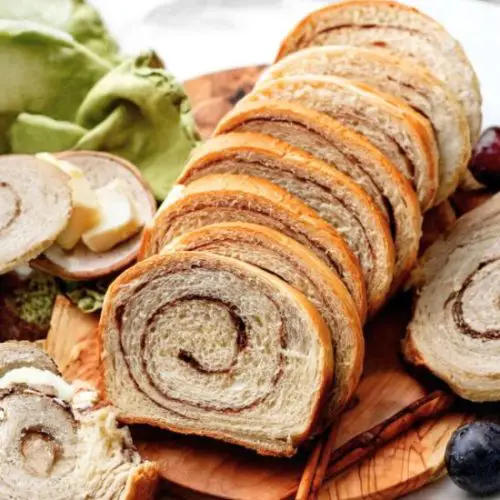
Cinnamon Swirl Bread
A soft, fluffy homemade cinnamon swirl bread with a rich, gooey cinnamon-sugar filling, perfect for breakfast, snacks, or sharing with family. This classic yeast bread is made from simple ingredients and features a tender crumb, aromatic cinnamon, and a lightly golden crust.
Equipment
- 1 Electric Stand Mixer with dough hook attachment
- 1 Rolling Pin (for dough shaping)
- 1 Pastry Brush (for egg wash and butter)
- 1 9×5-Inch Loaf Pan (for baking the bread)
- 1 Instant-Read Thermometer (for checking doneness)
Ingredients
For the Dough:
- ½ cup 120 ml warm water, about 110°F (43°C)
- ½ cup 120 ml warm whole milk, about 110°F (43°C)
- 2¼ teaspoons 7 g instant or active dry yeast (1 packet)
- ¼ cup 50 g granulated sugar, divided
- 4 tablespoons 56 g unsalted butter, softened and cut into pieces
- 3 cups 390 g bread flour, spooned and leveled, plus extra if needed
- 1 teaspoon salt
For the Cinnamon Swirl & Topping:
- 1 egg white lightly beaten
- ¼ cup 50 g granulated sugar
- 2 teaspoons ground cinnamon
- 1 tablespoon 14 g unsalted butter, melted
Instructions
- Activate the Yeast: In the bowl of a stand mixer fitted with a dough hook, combine the warm water, warm milk, yeast, and 2 tablespoons of sugar. Stir gently to mix and let it rest for 5 to 10 minutes, until the surface appears bubbly and foamy, signaling the yeast is alive and ready.
- Begin the Dough: Add the remaining sugar, softened butter, 1 cup of flour, and salt to the yeast mixture. Mix on low speed for about 30 seconds, then scrape the sides of the bowl to gather all ingredients. Gradually add the second cup of flour and mix on medium speed until partially combined, with bits of butter still visible. Finally, add the last cup of flour and mix until the dough forms and begins to pull away from the bowl edges, roughly 2 minutes. If the dough feels too sticky for kneading, sprinkle in additional flour one tablespoon at a time until manageable but still slightly tacky.
- Knead the Dough: Continue kneading the dough in the mixer for 8 to 10 minutes, or transfer it to a floured surface and knead by hand. If it becomes too sticky, lightly dust with flour. The dough should be soft and elastic. Test readiness by gently stretching a small piece until it becomes thin and translucent without tearing (the windowpane test).
- First Proof: Lightly grease a large bowl with oil or cooking spray. Shape the dough into a ball and place it inside, turning to coat all sides. Cover with a clean towel or plastic wrap, and allow it to rise in a warm place for about 1.5 to 2 hours, until it doubles in size.
- Prepare the Loaf Pan and Cinnamon Filling: Grease a 9×5-inch loaf pan. In a small bowl, whisk together the sugar and cinnamon for the swirl.
- Shape the Dough and Add Swirl: Punch down the risen dough to release gas. Lightly flour your work surface, rolling pin, and hands. Roll the dough into an approximately 8×20-inch rectangle, rough edges are fine. Using a pastry brush, spread the beaten egg white evenly over the surface, then sprinkle the cinnamon-sugar mixture, leaving about a 1-inch border on one side. Roll the dough tightly into a log starting from the long edge, and place it seam-side down into the prepared loaf pan. If any cinnamon sugar spills, sprinkle it on top of the loaf.
- Second Proof: Cover the loaf pan with a clean cloth and let the dough rise again for about 1 hour, or until the dough rises about 1 inch above the pan rim.
- Bake the Bread: Position your oven rack in the lower third and preheat the oven to 350°F (177°C). Before baking, brush the top of the loaf with the melted butter. Bake for 35 to 45 minutes, watching closely near the end. If the crust browns too quickly, tent the loaf with foil. The bread is done when it sounds hollow when tapped or reaches an internal temperature of 195–200°F (90–93°C) with an instant-read thermometer.
- Cool the Bread: Remove the bread from the oven and allow it to cool in the pan on a wire rack for a few minutes. Then, carefully transfer the loaf to the rack to cool completely before slicing.
Notes
- Overnight Rise Option: For enhanced flavor, prepare the dough through the first mixing stage and let it rise slowly overnight in the fridge. Bring to room temperature the next morning before shaping and continuing with the recipe. Avoid shaping the loaf the night before to prevent over-proofing.
- Freezing Tips: This bread freezes well baked or as dough. Wrap baked bread tightly in plastic wrap and foil, freeze up to 3 months. Thaw in the fridge overnight before warming. For dough, freeze after punching down, thaw in fridge overnight, then punch down again before shaping.
- Milk Variations: Whole or 2% milk works best for richness. Non-dairy milks may be substituted, but results can vary.
- Flour Selection: Use bread flour for best gluten development and rise. All-purpose flour may produce a less structured loaf.
- Optional Raisins: Add up to ¾ cup of raisins sprinkled over the egg white before adding cinnamon sugar for a fruity twist.
- Avoid Large Air Pockets: Make sure to brush the dough thoroughly with egg white before adding the cinnamon-sugar swirl. For extra steam release, poke a few holes in the top of the loaf with a toothpick before baking.